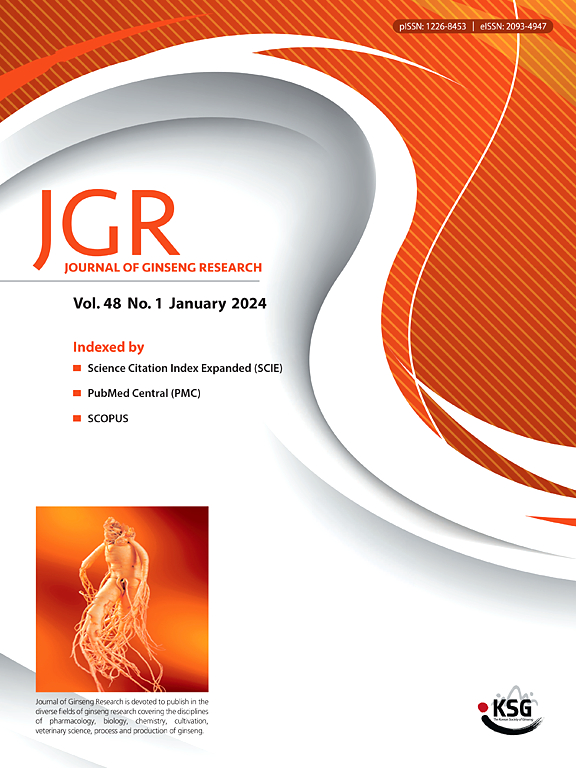Ginsenoside Re promotes osteogenic differentiation via BMP2/p38 pathway in vivo and in vitro
IF 6.8
2区 医学
Q1 CHEMISTRY, MEDICINAL
引用次数: 0
Abstract
Background
Ginsenosides have been used in traditional Chinese medicine to treat fractures. Ginsenoside Re, a key component of P. ginseng, however, the molecular mechanisms underlying these effects remain inadequately understood. This study aims to investigate the effects of Ginsenoside Re on bone formation in fractures and to explore the underlying molecular mechanisms involved.
Methods
Cell proliferation and osteogenic differentiation were evaluated using the Cell Counting Kit-8 (CCK-8) assay and alkaline phosphatase (ALP) staining, respectively. Quantitative PCR (qPCR) and western blotting were employed to quantify mRNA and protein expression levels. To assess bone formation in vivo, a zebrafish caudal fin regeneration model was utilized, with calcein staining applied to visualize mineralized tissue. Additionally, a bone morphogenetic protein 2a (bmp2a) knockout zebrafish model was generated using the CRISPR-Cas9 system to further investigate the molecular mechanisms underlying ginsenoside Re-mediated bone formation.
Results
Ginsenoside Re promotes normal development and survival in zebrafish. In a zebrafish model, ginsenoside Re enhances bone regeneration, accompanied by upregulated expression of osteogenic markers. Following a 10-day treatment with 20 μM ginsenoside Re, mRNA sequencing (mRNA-Seq) analysis identified bmp2a as a critical regulator of bone formation. In vitro, ginsenoside Re stimulates osteogenic differentiation in MC3T3-E1 cells, elevating both mRNA and protein levels of bone morphogenetic protein 2 (BMP2). Co-treatment with noggin or SB203580 reverses ginsenoside Re-induced osteogenesis: noggin suppresses BMP2 expression and p38 phosphorylation, whereas SB203580 specifically inhibits p38 activity. In a bmp2a knockout zebrafish model, the pro-osteogenic effects of ginsenoside Re are completely abolished. Similarly, in wild-type zebrafish, both noggin and SB203580 attenuate the bone-promoting effects of ginsenoside Re. Noggin reduces the expression of bmp2a and p38a, while SB203580 specifically targets p38a.
Conclusions
In conclusion, our findings demonstrate, for the first time, that ginsenoside Re at an optimal concentration of 20 μM enhances bone formation by modulating the osteogenic system. Mechanistically, we reveal that this pro-osteogenic effect is mediated through the BMP2/p38 signaling pathway.
人参皂苷Re在体内外通过BMP2/p38通路促进成骨分化
背景:人参皂苷在中药中用于治疗骨折。人参皂苷Re是人参的关键成分,然而,这些作用的分子机制尚不清楚。本研究旨在探讨人参皂苷Re对骨折骨形成的影响,并探讨其潜在的分子机制。方法分别采用细胞计数试剂盒-8 (CCK-8)法和碱性磷酸酶(ALP)染色法检测各组细胞增殖和成骨分化。采用定量PCR (qPCR)和western blotting检测各组mRNA和蛋白的表达水平。为了评估体内骨形成,我们利用斑马鱼尾鳍再生模型,钙黄蛋白染色显示矿化组织。此外,利用CRISPR-Cas9系统构建骨形态发生蛋白2a (bone morphogenetic protein 2a, bmp2a)敲除斑马鱼模型,进一步研究人参皂苷re介导骨形成的分子机制。结果人参皂苷Re能促进斑马鱼的正常发育和存活。在斑马鱼模型中,人参皂苷Re增强骨再生,并伴有成骨标志物的上调表达。用20 μM人参皂苷Re治疗10天后,mRNA测序(mRNA- seq)分析发现bmp2a是骨形成的关键调节因子。在体外,人参皂苷Re刺激MC3T3-E1细胞成骨分化,提高骨形态发生蛋白2 (bone morphogenetic protein 2, BMP2) mRNA和蛋白水平。与noggin或SB203580共同治疗逆转人参皂苷再诱导的成骨:noggin抑制BMP2表达和p38磷酸化,而SB203580特异性抑制p38活性。在bmp2a基因敲除的斑马鱼模型中,人参皂苷Re的促成骨作用被完全消除。同样,在野生型斑马鱼中,noggin和SB203580都减弱了人参皂苷Re的促骨作用。noggin降低了bmp2a和p38a的表达,而SB203580特异性靶向p38a。结论本研究首次证实,在最佳浓度为20 μM时,人参皂苷Re通过调节成骨系统促进骨形成。在机制上,我们揭示了这种促成骨作用是通过BMP2/p38信号通路介导的。
本文章由计算机程序翻译,如有差异,请以英文原文为准。
求助全文
约1分钟内获得全文
求助全文
来源期刊

Journal of Ginseng Research
CHEMISTRY, MEDICINAL-INTEGRATIVE & COMPLEMENTARY MEDICINE
CiteScore
11.40
自引率
9.50%
发文量
111
审稿时长
6-12 weeks
期刊介绍:
Journal of Ginseng Research (JGR) is an official, open access journal of the Korean Society of Ginseng and is the only international journal publishing scholarly reports on ginseng research in the world. The journal is a bimonthly peer-reviewed publication featuring high-quality studies related to basic, pre-clinical, and clinical researches on ginseng to reflect recent progresses in ginseng research.
JGR publishes papers, either experimental or theoretical, that advance our understanding of ginseng science, including plant sciences, biology, chemistry, pharmacology, toxicology, pharmacokinetics, veterinary medicine, biochemistry, manufacture, and clinical study of ginseng since 1976. It also includes the new paradigm of integrative research, covering alternative medicinal approaches. Article types considered for publication include review articles, original research articles, and brief reports.
JGR helps researchers to understand mechanisms for traditional efficacy of ginseng and to put their clinical evidence together. It provides balanced information on basic science and clinical applications to researchers, manufacturers, practitioners, teachers, scholars, and medical doctors.
 求助内容:
求助内容: 应助结果提醒方式:
应助结果提醒方式:


